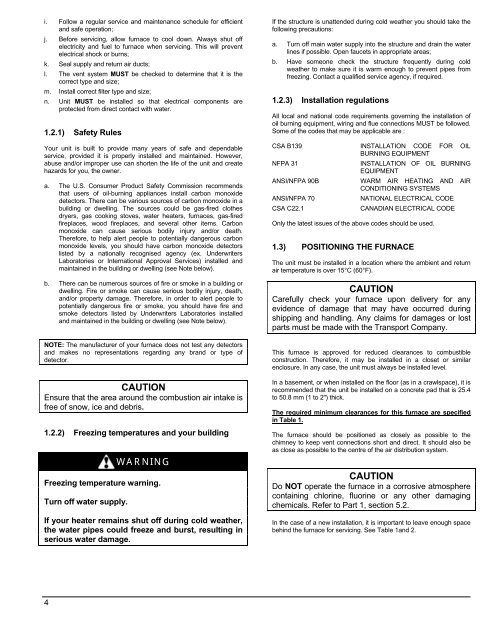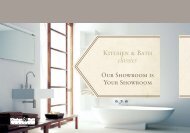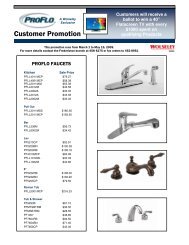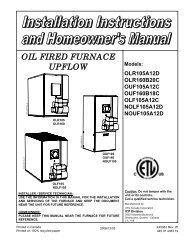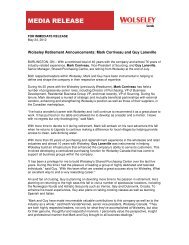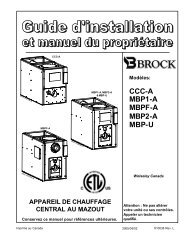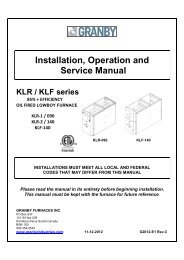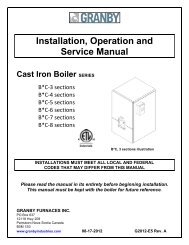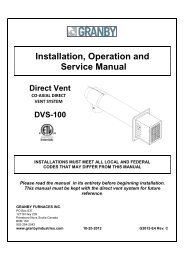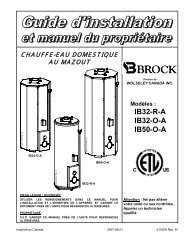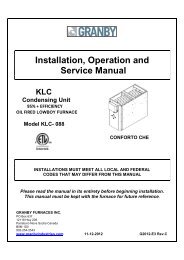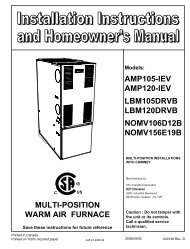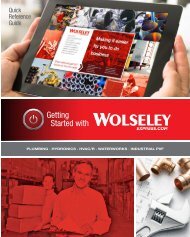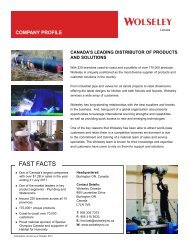OLR350H28B - Wolseley Canada Inc
OLR350H28B - Wolseley Canada Inc
OLR350H28B - Wolseley Canada Inc
Create successful ePaper yourself
Turn your PDF publications into a flip-book with our unique Google optimized e-Paper software.
i. Follow a regular service and maintenance schedule for efficient<br />
and safe operation;<br />
j. Before servicing, allow furnace to cool down. Always shut off<br />
electricity and fuel to furnace when servicing. This will prevent<br />
electrical shock or burns;<br />
k. Seal supply and return air ducts;<br />
l. The vent system MUST be checked to determine that it is the<br />
correct type and size;<br />
m. Install correct filter type and size;<br />
n. Unit MUST be installed so that electrical components are<br />
protected from direct contact with water.<br />
1.2.1) Safety Rules<br />
Your unit is built to provide many years of safe and dependable<br />
service, provided it is properly installed and maintained. However,<br />
abuse and/or improper use can shorten the life of the unit and create<br />
hazards for you, the owner.<br />
a. The U.S. Consumer Product Safety Commission recommends<br />
that users of oil-burning appliances install carbon monoxide<br />
detectors. There can be various sources of carbon monoxide in a<br />
building or dwelling. The sources could be gas-fired clothes<br />
dryers, gas cooking stoves, water heaters, furnaces, gas-fired<br />
fireplaces, wood fireplaces, and several other items. Carbon<br />
monoxide can cause serious bodily injury and/or death.<br />
Therefore, to help alert people to potentially dangerous carbon<br />
monoxide levels, you should have carbon monoxide detectors<br />
listed by a nationally recognised agency (ex. Underwriters<br />
Laboratories or International Approval Services) installed and<br />
maintained in the building or dwelling (see Note below).<br />
b. There can be numerous sources of fire or smoke in a building or<br />
dwelling. Fire or smoke can cause serious bodily injury, death,<br />
and/or property damage. Therefore, in order to alert people to<br />
potentially dangerous fire or smoke, you should have fire and<br />
smoke detectors listed by Underwriters Laboratories installed<br />
and maintained in the building or dwelling (see Note below).<br />
NOTE: The manufacturer of your furnace does not test any detectors<br />
and makes no representations regarding any brand or type of<br />
detector.<br />
CAUTION<br />
Ensure that the area around the combustion air intake is<br />
free of snow, ice and debris.<br />
1.2.2) Freezing temperatures and your building<br />
WARNING<br />
Freezing temperature warning.<br />
Turn off water supply.<br />
If your heater remains shut off during cold weather,<br />
the water pipes could freeze and burst, resulting in<br />
serious water damage.<br />
If the structure is unattended during cold weather you should take the<br />
following precautions:<br />
a. Turn off main water supply into the structure and drain the water<br />
lines if possible. Open faucets in appropriate areas;<br />
b. Have someone check the structure frequently during cold<br />
weather to make sure it is warm enough to prevent pipes from<br />
freezing. Contact a qualified service agency, if required.<br />
1.2.3) Installation regulations<br />
All local and national code requirements governing the installation of<br />
oil burning equipment, wiring and flue connections MUST be followed.<br />
Some of the codes that may be applicable are :<br />
CSA B139 INSTALLATION CODE FOR OIL<br />
BURNING EQUIPMENT<br />
NFPA 31<br />
INSTALLATION OF OIL BURNING<br />
EQUIPMENT<br />
ANSI/NFPA 90B WARM AIR HEATING AND AIR<br />
CONDITIONING SYSTEMS<br />
ANSI/NFPA 70<br />
NATIONAL ELECTRICAL CODE<br />
CSA C22.1<br />
CANADIAN ELECTRICAL CODE<br />
Only the latest issues of the above codes should be used.<br />
1.3) POSITIONING THE FURNACE<br />
The unit must be installed in a location where the ambient and return<br />
air temperature is over 15°C (60°F).<br />
CAUTION<br />
Carefully check your furnace upon delivery for any<br />
evidence of damage that may have occurred during<br />
shipping and handling. Any claims for damages or lost<br />
parts must be made with the Transport Company.<br />
This furnace is approved for reduced clearances to combustible<br />
construction. Therefore, it may be installed in a closet or similar<br />
enclosure. In any case, the unit must always be installed level.<br />
In a basement, or when installed on the floor (as in a crawlspace), it is<br />
recommended that the unit be installed on a concrete pad that is 25.4<br />
to 50.8 mm (1 to 2") thick.<br />
The required minimum clearances for this furnace are specified<br />
in Table 1.<br />
The furnace should be positioned as closely as possible to the<br />
chimney to keep vent connections short and direct. It should also be<br />
as close as possible to the centre of the air distribution system.<br />
CAUTION<br />
Do NOT operate the furnace in a corrosive atmosphere<br />
containing chlorine, fluorine or any other damaging<br />
chemicals. Refer to Part 1, section 5.2.<br />
In the case of a new installation, it is important to leave enough space<br />
behind the furnace for servicing. See Table 1and 2.<br />
4


